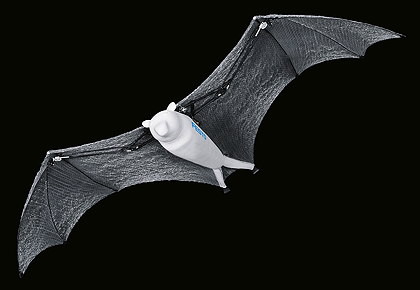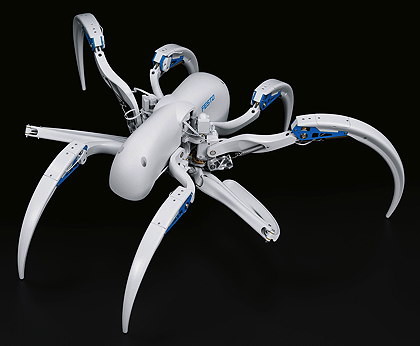- Home » News » Technology News
Bionic spider will roll or run, while fruit bat flies overhead

A camera-guided flying fruit bat, and a spider that that can both walk and roll, are the latest additions to Festo’s menagerie of bionic creatures that will make their debuts at this year’s Hannover Fair in April. Festo has established a tradition of developing bionic versions of real animals that attract vast number of visitors to its stand at Hannover every year.
This year it will have two new attractions. The first is a version of a fruit bat – also known as a “flying fox” – which weighs just 580 grams and has a 2.8m-wide wingspan. Called the BionicFlyingFox, it will be capable of semi-autonomous flight, controlled by a ground-based motion-tracking system which uses two infrared cameras which follow four infrared LEDs mounted on its legs and wings.
Images from the cameras go to a computer which evaluates the data and coordinates the bat’s flight. Its wing movements are calculated using on-board electronics, with a 9g brushless DC motor driving the flapping of the wings via a rack-and-pinion gear system. Take-off and landing are controlled by a human operator.
During the fruit bat’s flight, the master computer compares the calculated intended courses with the actual ones, and adjusts them with increasing efficiency using machine learning. The BionicFlyingFox detects how it must control its wings and legs to implement the commands from the computer in an optimal manner.
The ultralight flying object uses intricate kinematics based on the scissors principle, allowing it to turn with tight radii. The “bat” has a secondary wing which is retracted during the upstroke, and is unfolded again to produce powerful downward strokes. Like a real fruit bat, the mechanical version can fold its lightweight, elastic wings and hang upside down to “rest”. The folding is achieved using two small linear drives.
The second bionic creature making its debut at Hannover is based on a curious type of spider that was discovered on the edge of the Sahara Desert in 2008 by a German bionics expert, Professor Ingo Rechenberg. Dubbed the “cyclist” or “flic-flac” spider, it can not only run, but also propel itself into the air using a combination of somersaults and rolling. In smooth areas it can roll twice as fast as it can run, but on uneven surfaces, it runs faster.

Prof Rechenberg has worked with Festo’s experts to develop a bionic version, called the BionicWheelBot, which can walk using six legs driven by a combination of 15 motors and gearboxes located in its body and leg joints. The 570mm-long and 238mm-tall spider also contains 14 worm-gears that lock automatically to keep it upright when it is standing still.
The six walking legs can be retracted to form a wheel, and two more legs, which are retracted while running, are then extended. With the spider rolled up like a ball, these legs push it off the ground and propel it forwards in a continuous rolling motion. The spider can also turn on the spot using its two longest legs to push its body upwards, before turning to face the required direction.
The BionicWheelBot is controlled remotely from a tablet computer.






